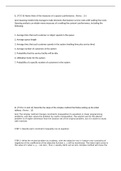Exam (elaborations)
GSCM 209 Final - 1. (TCO 8). Questions and Answers.
- Course
- Institution
GSCM 209 Final - 1. (TCO 8). Questions and Answers. 1. (TCO 8) Name three of the measures of a queue’s performance. (Points : 15) Ans) Queuing models help managers make decisions that balance service cost s with waiting-line costs. Queuing analysis can obtain many measures of a waiting-line sy...
[Show more]



